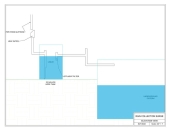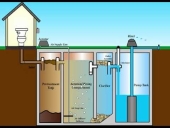
 1
1




 1
1








Douglas Alpenstock wrote:As a septic system owner, I am interested in what people have to say. If there is a better method than a sucker truck every few years that discharges into municipal treatment, I'm interested.
But I have nowhere near the volumes you're talking about. This seems like an industrial/agricultural scale system.
 1
1








Douglas Alpenstock wrote:It takes a lot of aeration to break down unfavourable report cards. ;-)
 3
3




Invasive plants are Earth's way of insisting we notice her medicines. Stephen Herrod Buhner
Everyone learns what works by learning what doesn't work. Stephen Herrod Buhner
 1
1




A human being should be able to change a diaper, plan an invasion, butcher a hog, conn a ship, design a building, write a sonnet, balance accounts, build a wall, set a bone, comfort the dying, take orders, give orders, cooperate, act alone, solve equations, analyze a new problem, pitch manure, program a computer, cook a tasty meal, fight efficiently, die gallantly. Specialization is for insects.
-Robert A. Heinlein
 1
1




Om is where the heart is.
 1
1




 1
1








Pete Podurgiel wrote:Hi Steven:
My $0.02 ...I'd leave it be. My gut tells me there would be no advantage to aeration and could perhaps be detrimental to the system.
- as nitrogen is water soluable, it will leave the septic tank with the black water and be dispersed into the soil through the leaching field. The microbiome in the leaching field will then utilize and filter out the nitrogen.
- if adding air into a system, air will need to leave the system. The air leaving will be awfully smelly and may even contain pathogens. A properly operating septic system should have no smell.
- when the tank is pumped, the solids are probably brought to a municipal waste treatment facility. These facilities often have aerators (hence the bad smell), the remaing sludge is probably incinerated.
I would not mess with the black water due to the possible presence of pathogens ...let the system operate as it was designed. If you are in an arid region, the waste water percolating into the soil may be beneficial to trees, but do not plant trees directly on top of or direcctly adjacent tor your leaching field. The roots will infiltrate the system and you will have problems ....that's assuming you have leaching trenches, leaching galleries may fair better, but I still would not risk it. If the leaach field is on a slope, you may consider planting trees downgradient from the system, they may possibly utilize the waster water and not interfere with the proper operatin of the system.
Assuming the system is relatively new, a system of that size was most likely designed by an engineer. You may be able to go to the local health and/or planning department and see if there are any plans on file showing the septic system design. This will give you a better idea with what you have to work with.
Hope this helps,
-Pete




Chris Kott wrote:I mean, paper is carbon, so technically, they should actually speed up decomposition, shouldn't they?
Steve, I would look at the way that liquid cow feces is, in some places, processed to yield methane and a partially metabolised feedstock for further composting or process. A truly astounding quantity goes into a large, sealed tank, with internal infrastructure to swirl the contents. All materials in addition to the feces necessary for efficient methanogenesis are added, and it cooks in a methane-generating environment until a threshold is reached wherein there is no longer enough feedstock remaining to fuel the process.
So you get a natural gas you can cook with or perhaps even heat something with, and a feedstock for an aerated process to finish the composting. I like this idea because we get to use what otherwise would offgas into the atmosphere as fuel. Also, while it is possible to have a second-stage tank that would function identically to the methane bioreactor but with an oxygen-based process more like the brewing of actively aerated compost tea, which would be my preference, providing I can get the lab equipment to do regular testing, it is also possible to apply the solids directly to windrows of organic material to be composted, providing the process happens on healthy soil unlikely to be contaminated by errant, oxygen-starved pathogens.
How does this apply to you? That's a great question. You indicate that you have way more capacity than you presently require. I would try to quantify that, because if you're at capacity, you really don't have much time at all to experiment, whereas if you're even three-quarters-full on a system that is easily a hundred times greater than your personal need, you might have time to get the right biological conditions working for you in your septic tank and fields.
First-off, I wonder if anyone in your position has tried turning their over-large septic system into a methane generator. I mean, any large inverted container, a food-grade barrel with a bung near the bottom, could be floated in an IBU full of water as the seal. The bung could be tapped for gas, and the barrel would become buoyant as the volume of gas increased.
But as useful as this would be in the right situation, it seems rather like a stage added between plumbing and septic, wherein the solids are processed in a first-stage bioreactor as described above, and then drained to the septic tank.
If you're not familiar with compost extracts, and specifically actively aerated compost extracts, brushing up might be enlightening. Basically, I suggest you try operating your system almost exactly as intended, except that you brew and add actively aerated compost extract to the system regularly, atop the tank, and over the whole leaching field. To this, I would also add regular fungal slurry applications, probably something relatively hardy and aggressive like oyster mushroom.
Structurally, I think that if the tank and field were designed to vent, make sure those aren't obstructed. The problem I see with any other type of aeration is that your system already exists. Short of needing to replace it, where everything might be dug up, or at least a new one installed elsewhere, and you'd have unfettered access to install something like weeping tile inside your tank itself, whose ends you could extend up out of the ground, perhaps one extending into a black metal chimney, that would power a passive aeration of your tank as the hot air sought to escape, pulling fresh in from the other end of the weeping tile.
Adding appropriate biology would outcompete native and incoming pathogens, and adding oyster mushrooms, along with making sure there is enough carbon in and around the soil, will ensure that anything escaping the tank at any stage will be met with mycological resistance that will not only break them down, but redistribute things where they are needed.
I would love to hear from someone with more direct experience than I on the potential for mycology and actively aerated compost extracts to decrease volume inside a septic tank, but theoretically, if your capacity is high enough, you might be able to use a mycelial superhighway to keep your septic system clear.
And in the event that it doesn't address volume concerns, at least you'll know that what you're pumping out could go straight into your garden, or at least your woodlot and ornamentals.
But in any case, let us know how it goes, and good luck.
-CK

|
Are we home yet? Wait, did we forget the tiny ad?
Freaky Cheap Heat - 2 hour movie - HD streaming
https://permies.com/wiki/238453/Freaky-Cheap-Heat-hour-movie
|






